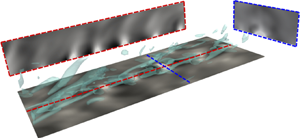Article contents
Trapped waves in supersonic and hypersonic turbulent channel flow over porous walls
Published online by Cambridge University Press: 11 June 2021
Abstract

This study investigates the effect of an isothermal wall with complex impedance on compressible turbulent channel flow up to bulk Mach numbers of  $6.00$. Such investigation is carried out via the time-domain impedance boundary conditions based on auxiliary differential equations method. A three-parameter complex impedance, modelling a frequency-selective porous wall, with tuneable resonating frequency
$6.00$. Such investigation is carried out via the time-domain impedance boundary conditions based on auxiliary differential equations method. A three-parameter complex impedance, modelling a frequency-selective porous wall, with tuneable resonating frequency  $\omega _{res}$ and variable resistance
$\omega _{res}$ and variable resistance  $R \in [0.10, 1.0]$ is employed. Higher resistance leads to lower wall permeability with
$R \in [0.10, 1.0]$ is employed. Higher resistance leads to lower wall permeability with  $R \rightarrow \infty$ representing the impermeable limit. Three bulk Mach numbers
$R \rightarrow \infty$ representing the impermeable limit. Three bulk Mach numbers  $M_b = \{1.50, 3.50, 6.00\}$ are investigated with a semi-local Reynolds number
$M_b = \{1.50, 3.50, 6.00\}$ are investigated with a semi-local Reynolds number  $Re_\tau ^{*} \approx 220$. It is found that a sufficiently low
$Re_\tau ^{*} \approx 220$. It is found that a sufficiently low  $R$ could trigger flow instabilities, which comprise streamwise-travelling waves in the near-wall region, akin to spanwise rollers at low subsonic flow conditions and second-mode waves at hypersonic conditions. The probability density function of instantaneous wall-shear stress shows an enhancement in extreme positive cases of wall-shear stress fluctuations, leading to an increase in the mean wall-shear stress due to porous walls. The wave dynamically affects the turbulence, yielding a local peak near the wall in the pre-multiplied spectrum of the production term of turbulence kinetic energy. Linear stability analysis using the turbulent base flow profile confirmed that the finite wall permeability triggers the instability when
$R$ could trigger flow instabilities, which comprise streamwise-travelling waves in the near-wall region, akin to spanwise rollers at low subsonic flow conditions and second-mode waves at hypersonic conditions. The probability density function of instantaneous wall-shear stress shows an enhancement in extreme positive cases of wall-shear stress fluctuations, leading to an increase in the mean wall-shear stress due to porous walls. The wave dynamically affects the turbulence, yielding a local peak near the wall in the pre-multiplied spectrum of the production term of turbulence kinetic energy. Linear stability analysis using the turbulent base flow profile confirmed that the finite wall permeability triggers the instability when  $R$ is below a threshold
$R$ is below a threshold  $R_{{cr}}$, which shows a sub-linear proportionality on the bulk Mach number
$R_{{cr}}$, which shows a sub-linear proportionality on the bulk Mach number  $M_b$. The perturbed field exhibits more dilatational nature in high Mach number flows with low permeability.
$M_b$. The perturbed field exhibits more dilatational nature in high Mach number flows with low permeability.
- Type
- JFM Papers
- Information
- Copyright
- © The Author(s), 2021. Published by Cambridge University Press
Footnotes
The online version of this article has been updated since original publication. A notice detailing the change has also been published
References
REFERENCES
A correction has been issued for this article:
- 17
- Cited by
Linked content
Please note a has been issued for this article.



